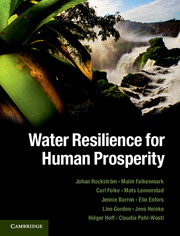Book contents
- Frontmatter
- Contents
- List of Contributors
- Preface
- Introduction to the book
- Acknowledgements
- Part I A new perspective
- Part II Living in a human-dominated world
- 2 Human modification of the Earth System
- 3 Balancing on a threshold of alternate development paths: regime shift, traps and transformations
- 4 Crucial functioning of and human dependence on the global water system
- Part III Food production globally: in hotspot regions and in the landscape
- Part IV Governance and pathways
- Glossary
- Index
- References
2 - Human modification of the Earth System
from Part II - Living in a human-dominated world
Published online by Cambridge University Press: 05 August 2014
- Frontmatter
- Contents
- List of Contributors
- Preface
- Introduction to the book
- Acknowledgements
- Part I A new perspective
- Part II Living in a human-dominated world
- 2 Human modification of the Earth System
- 3 Balancing on a threshold of alternate development paths: regime shift, traps and transformations
- 4 Crucial functioning of and human dependence on the global water system
- Part III Food production globally: in hotspot regions and in the landscape
- Part IV Governance and pathways
- Glossary
- Index
- References
Summary
The focus in this chapter is the human forcings in the Earth System at large, and their origin in multiple drivers of change: demographic, economic development, urbanisation, technological development, international trade and foreign direct investment, climate change, and national and international policies. The chapter shows in what ways the Earth System has responded by different kind of impacts and feedbacks, and discusses the risk of approaching crucial thresholds and tipping points in the Earth System. Special attention is paid to the world’s most water-dependent system: agricultural production and human food security.
Humans have altered the Earth System through multiple drivers of change
Anthropogenic pressures are multiple, complex and equal in magnitude to some of the great forces of nature – and they are accelerating. They interact with each other and can trigger abrupt, non-linear changes if they cross critical thresholds. It has been recognised for some time that key environmental parameters have moved well beyond the range of natural variability, and that the magnitude and rate of change are unprecedented (from the Amsterdam Declaration on Global Change; Moore et al., 2001).
The Earth System is seen, in this book, as the highest level unit containing connected sub-systems and components at all scales, with levels of organisation beyond individual building blocks. Given the complexity of this system, it will not be possible to anticipate all the pressures, interactions and feedbacks between the different components. We should expect further surprises, including non-linear responses and sudden regime shifts or abrupt, often unexpected, changes resulting from a disturbance or shock – usually resulting in an alternate stable state – as well as large and persistent changes in structure and function.
A key driver of change is the need to increase food production and associated biomass appropriation for a growing, more affluent and increasingly urbanised population (resulting in increasing competition for water, land and other natural resources). The impacts of this driving force vary between different regions.
- Type
- Chapter
- Information
- Water Resilience for Human Prosperity , pp. 46 - 67Publisher: Cambridge University PressPrint publication year: 2014



